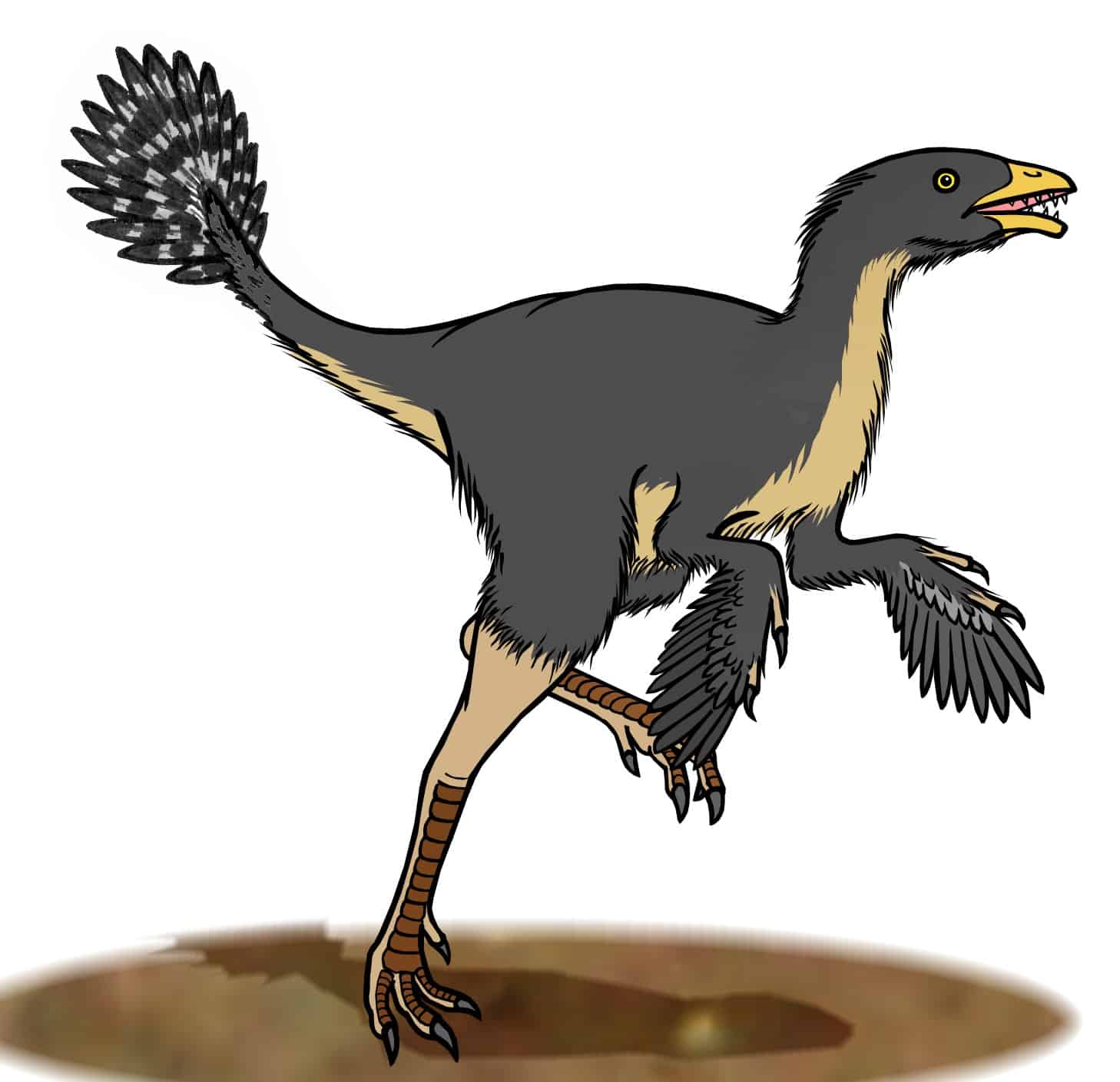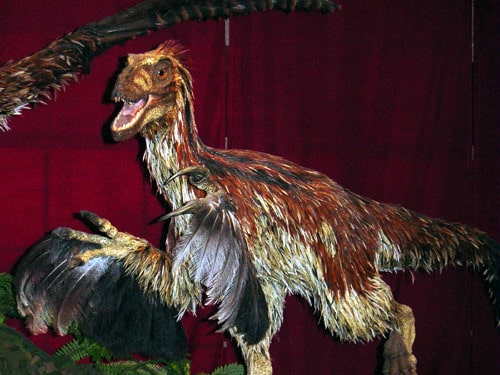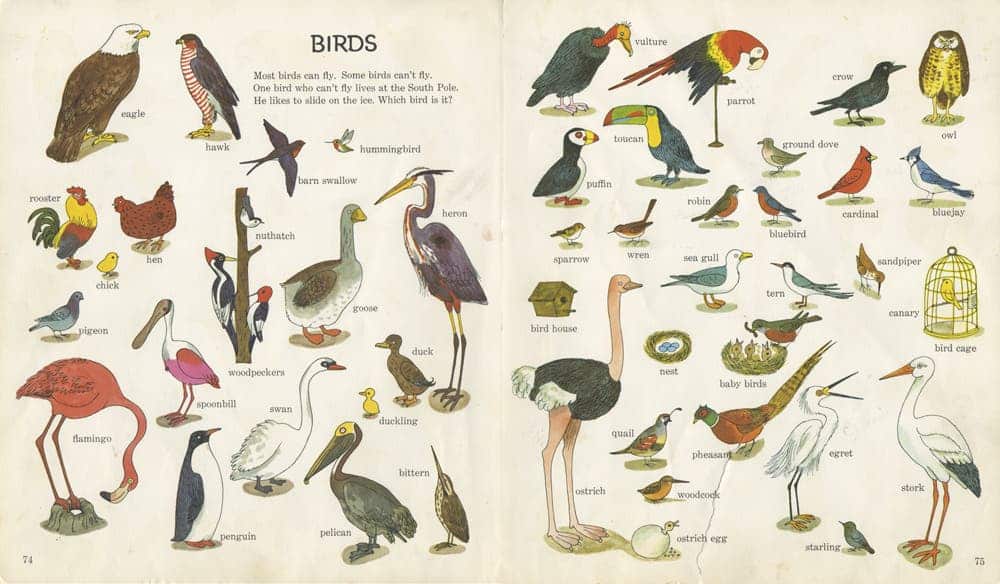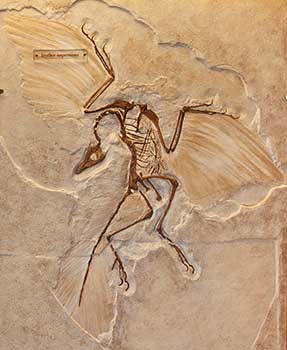Birds are dinosaurs. Yes, really. That pigeon you see in the park? Dinosaur. Parrots? Dinosaurs. That chicken nugget? Yep… you can eat dinosaurs. But it’s not that straightforward.

Feathery connection to dinosaurs
People often say that birds are related to dinosaurs, but that’s not true – birds aren’t related to dinosaurs… they are dinosaurs.
Let’s start with the beginning. Dinosaurs, those colossal creatures that roamed our planet millions of years ago, weren’t just the fearsome T-Rex or the long-necked Brachiosaurus. They were an incredibly diverse group. Among this vast variety existed a group called theropods. These bipedal, mostly carnivorous creatures gave rise to what we today recognize as birds.
Theropods are a group of two-legged, mostly carnivorous dinosaurs. The word “theropod” comes from the Greek word for “beast foot.” There are some pretty famous theropod dinosaurs:
- Tyrannosaurus rex: Possibly the most famous dinosaur of all, this massive predator is the poster child for theropods.
- Velociraptor: These were smaller but believed to be swift and intelligent hunters.
- Allosaurus: Another well-known predator from the Jurassic period.
- Birds: and yes, birds. Modern birds are not only descended from theropods but are considered to be living theropods.
Theropods, birds
Theropods are especially significant in the study of evolution because they bridge the connection between ancient dinosaurs and modern birds. Over time, certain theropods began to exhibit features we associate with birds, such as feathers. These bird-like theropods gave rise to the very first birds.
Birds emerged during the Jurassic period some 150 million years ago. That means that birds, as a group, emerged well before T. Rex or the velociraptor. These ancient birds looked a lot like dinosaurs, and in fact, some dinosaurs also looked like birds. Jurassic Park doesn’t show the velociraptor’s feathers, but this dinosaur was covered in feathers.
An important distinction: flying reptiles like pterodactyls are not birds. They’re not even related to birds. This is an example of convergent evolution (two different animal groups evolving to do the same thing), like with bats and birds. Nope, birds are more related to T. Rex than to pterodactyls.
Theropods are characterized by hollow bones and three toes and claws on each limb. They’re also mostly carnivorous (although not all birds are strictly carnivorous, most are at least omnivores).
The meteorite killed dinosaurs — all but one group
Let’s rewind a bit.
About 65 million years ago, a huge extinction wiped out all dinosaur groups except for one. That group of dinosaurs went on to become all the birds we see today.

There are obvious evolutionary links between this exceptional living group of birds and their Mesozoic relatives says Dr Roger Benson of Oxford University’s Department of Earth Sciences, who led a study on dinosaur evolution.
‘Dinosaurs aren’t extinct; there are about 10,000 species alive today in the form of birds. We wanted to understand the evolutionary links between this exceptional living group, and their Mesozoic relatives, including well-known extinct species like T. rex, Triceratops, and Stegosaurus,’ said Dr. Roger Benson of Oxford University’s Department of Earth Sciences, who led a study on the connection between birds and dinosaurs. ‘We found exceptional body mass variation in the dinosaur line leading to birds, especially in the feathered dinosaurs called maniraptorans. These include Jurassic Park’s Velociraptor, birds, and a huge range of other forms, weighing anything from 15 grams to 3 tonnes, and eating meat, plants, and more omnivorous diets.’
Dinosaurs were the dominant life forms on land for 135 million years until a great extinction wiped most of them out. The cause of that extinction is still a matter of debate, but the most likely option seems to be an asteroid impact (though volcano eruption may have also played a role).
Dinosaurs are generally split into two major groups – Saurischia and Ornithischia.
- The Saurischia includes all the carnivorous dinosaurs (theropods) and the giant, herbivorous dinosaurs (sauropods). The theropods are the more “popular” carnivorous dinosaurs, such as the T-Rex or the velociraptor, while the sauropods are the largest animals to ever walk on land;
- The Ornithischia are an order of beaked, herbivorous dinosaurs. The more notable dinosaurs of the group are the Stegosaurus and Iguanodon.
Interestingly enough, birds evolved from the Saurischian dinosaurs. In other words, theropods are a type of Saurischian dinosaurs.
Dinosaur body size evolved very rapidly in early forms, likely associated with the invasion of new ecological niches. In general, rates slowed down as these lineages continued to diversify,” said Dr David Evans at the Royal Ontario Museum, also an expert on bird evolution. “But it’s the sustained high rates of evolution in the feathered maniraptoran dinosaur lineage that led to birds – the second great evolutionary radiation of dinosaurs.”

Birds take flight
Birds are a member of Maniraptora, a group of theropods. It may seem strange that they actually emerged from dinosaurs, but today, most paleontologists agree that several dinosaurs were covered in feathers, which makes it a bit more acceptable. Their bones were also very light, they laid eggs, and despite their overall look, they have many things in common even with modern birds.
Of course, the transition took place over millions and millions of years, with several key transitions. The most well-known transitional fossil is Archaeopterix, the so-called missing link between reptiles and birds.
Archaeopteryx lived in the Late Jurassic period around 150 million years ago when Europe was an archipelago of islands in a shallow warm tropical sea. The species is one of the clearest examples of transitional species, showing characters from both dinosaurs and birds. Most of the fossils found include impressions of feathers, which only rarely become conserved in fossils. Because these feathers are of an advanced form (flight feathers), these fossils are evidence that the evolution of feathers began before the Late Jurassic.
However, it took quite a while before birds started diversifying. For tens of millions of years, birds still had clawed wings and teeth. Truly modern birds appeared 100 million years ago, way before the massive extinction that wiped out the dinosaurs. While they were never really on top of the food chain, they are the only branch of dinosaurs to survive past the Cretaceous (if you haven’t already, get used to the idea: birds are dinosaurs).
Modern birds are characterized by a beak with no teeth and a high metabolic rate and rate of growth. Most can fly, with some exceptions. They also have several other adaptations specifically aimed at flying.
So, birds are reptiles?

Well… yes, in a way, birds are reptiles in a sense, but it’s more complicated than that.
Biologists use two types of classification systems, the Linnaean and the phylogenetic. Depending on the classification system you use, birds are or aren’t reptiles.
Classifying birds
In contrast, the phylogenetic classification, or cladistics, represents a shift toward understanding these evolutionary ties. Developed in the mid-20th century but rooted in older ideas, this system uses both physical characteristics and molecular data, like DNA sequences, to determine relationships. Organisms are grouped based on clades, representing branches on the evolutionary tree where members share a common ancestor. Thus, using this system, a bird would be more closely related to reptiles like crocodiles than to bats. In essence, while the Linnaean system gave us a foundation, the phylogenetic approach provides a more nuanced picture of life’s interconnectedness.
The Linnaean system, developed by Carl Linnaeus in the 18th century, is a hierarchical method based on ranks such as Kingdom, Phylum, and Species, primarily using morphological (physical) traits. While simple and structured, this method can sometimes miss the complexities of evolutionary relationships. For instance, using this system, a bat and a bird might be grouped closely because both have wings, despite being evolutionarily distant.
In the Linnaean classification, a reptile is an animal that is cold-blooded and has scales – so in this sense, a bird is not a reptile. But in modern biology, people tend to follow the phylogenetic classification – that is, animals are grouped by their ancestry, and in this way, birds kind of are reptiles. It’s counterintuitive, but the question is only particularly useful for classification purposes, and both these systems have different uses.
Bird relatives
The question that emerges now is: if birds are indeed reptiles, what are their closest relatives? In terms of dinosaurs, it’s raptors and a type of theropod dinosaurs.
Our revised evolutionary tree supports the traditional relationship of dromaeosaurid (‘raptors’) and troodontid theropods as the closest relatives of birds. It also supports the status of the controversial anchiornithine theropods as the earliest birds”, said Rui Pei, at Hong Kong University. “With this improved evolutionary tree, the team reconstructed the potential of bird-like theropods for powered flight, using proxies borrowed from the study of flight in living birds.
Strangely enough, in terms of current species, birds are most closely related to crocodiles. But while crocodiles have remained mostly unchanged for tens of millions of years, birds have changed and adapted – which is why we see this stunning bird diversity today.
In summary: birds are dinosaurs
The notion that birds are dinosaurs isn’t just a whimsical idea. It’s backed by hard science. It changes how we perceive the world around us and, more importantly, underscores the ever-astonishing narrative of life on Earth.
So the next time you gaze at a bird, you’re looking at a living, breathing piece of history. You’re looking at a group of creatures that withstood one of the worst extinction moments in our planet’s history and outlives the rest of the dinosaurs







